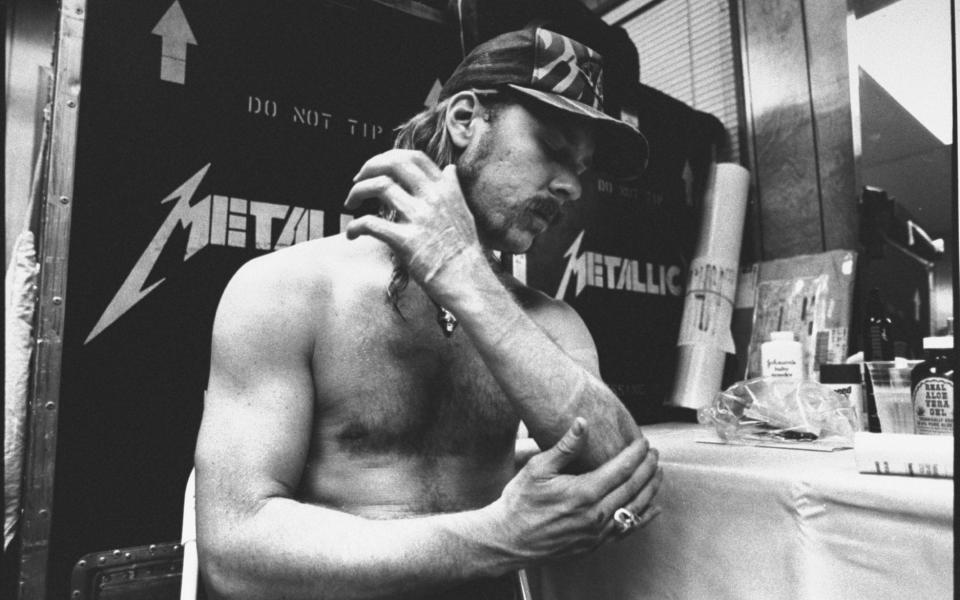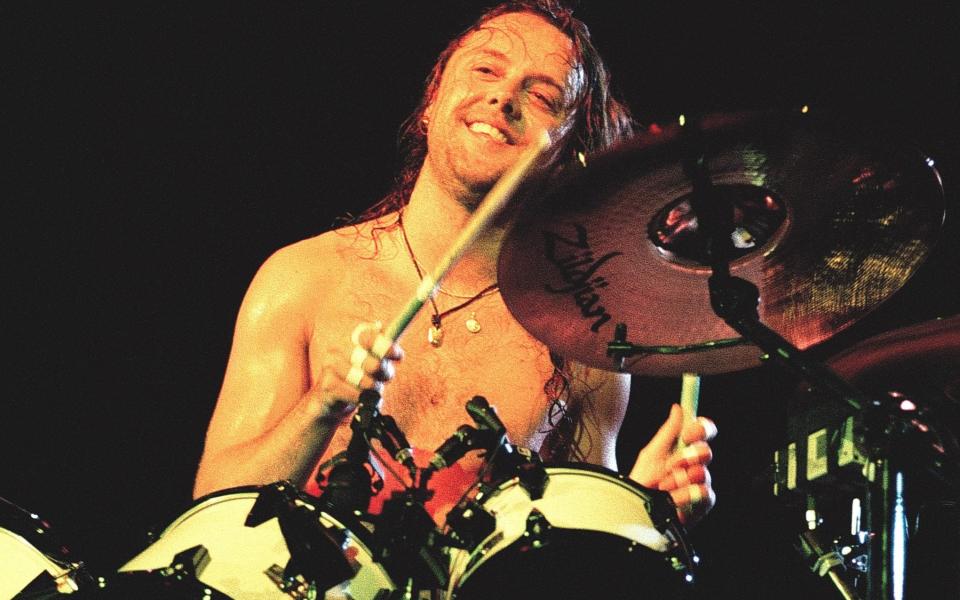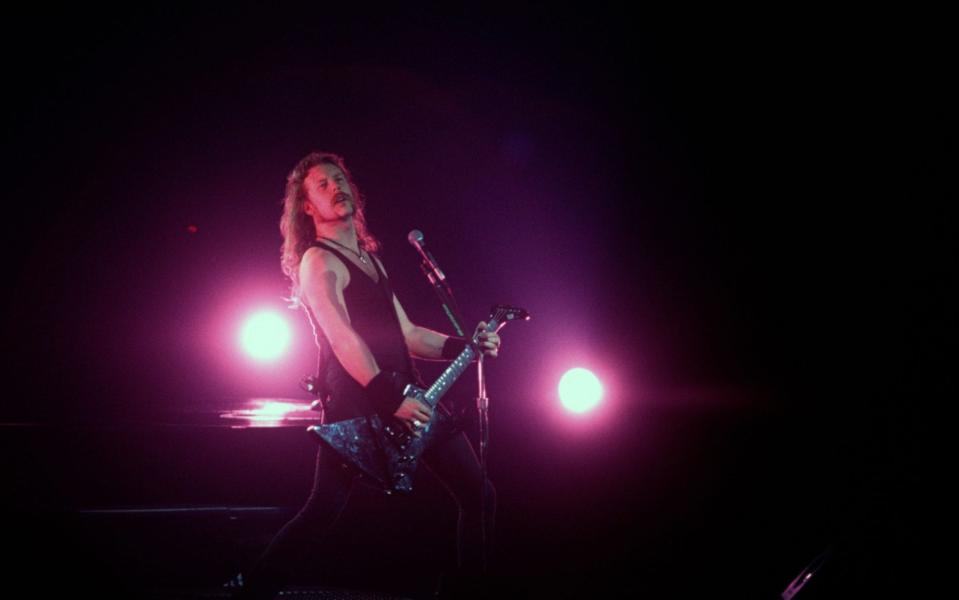Metallica, Guns N’ Roses and the incendiary US tour that almost killed them

According to Metallica’s website, the reason the group’s appearance at the Stade Du Parc Olympique, in Montreal, on August 8 1992 was curtailed after only 10-songs was because of “a pyro accident” involving singer and rhythm-guitarist James Hetfield. With an economy entirely untypical of the San Franciscan metal group, what isn’t mentioned is that the frontman’s misfortune in standing within range of an onstage explosion began a chain reaction that ended in a campaign of violence by large sections of a crowd of more than 50,000 people.
That summer, Metallica were on the road in North America with Guns N’ Roses. Booked into only the largest outdoor venues in the United States and Canada, the tour saw two of the most popular bands in loud music share a stage for the first time in a co-headline caravan in which gate receipts were divided evenly between them. With eventual ticket sales of 1.2 million, there would be plenty to go around. Fully aware of Guns N’ Roses singer Axl Rose’s growing reputation for arriving late to work, Metallica opted to play first for each of the campaign’s nominal 25-dates.
They were right to do so. As if appearing onstage in Montreal three hours after their designated stage-time wasn’t quite enough, Rose’s decision to cut his band’s set short after only nine songs – one fewer than Metallica themselves had managed – served to throw sparks into the tinder box that was the Olympic Stadium. “We got it together in Europe only to have it fall apart here,” were the singer’s parting words for the night. “If anyone is interested,” he added (incorrectly, as it goes), “this is going to be our last show for a long time.”
As James Hetfield underwent treatment at Montreal General Hospital for second-degree burns on his left arm and hand – bassist Jason Newsted would later recall that his bandmate’s flesh was “bubbling… like the Toxic Avenger” – announcers at the stadium pleaded for calm.
Unpersuaded, a section of the crowd began systematically breaking the place apart, looting the merchandise stalls, ransacking the bars and hurling chairs through the plate-glass windows of the corporate boxes. As the turmoil spread, 300 riot police were deployed to fire tear gas through the streets. Four subway stations were closed.

As one ticket-holder reported, “By the time we got outside [the Olympic Stadium], the crowd were already tearing everything apart: turning over cop cars, smashing windows and just going crazy… People weren’t beating each other, so it didn’t feel dangerous, but it was just like this group effort to destroy everything around them. It was basically 50,000 angry French-Canadians trying to tear the stadium apart.”
But there was trouble before it even began. Barely a week before the tour’s opening date at the RFK Stadium in Washington DC, on July 17, Axl Rose appeared in court in Missouri on charges relating to his part in a riot the previous year at a Guns N’ Roses concert in St Louis that had resulted in damage totalling $200,000 to the then brand new Riverside Performing Arts Center. Doubtless chastened by the prospect of similar scenes, authorities in Chicago, Cleveland and Philadelphia were among the first cities to instantly reject the opportunity to host this latest extravaganza.
Elsewhere, though, money talked. With projected ticket grosses of $1.8 million dollars per night, the tour was given the go-ahead to visit 24 metropolises with varying degrees of enthusiasm. Wary of a running-order that might feasibly have seen concerts ending at 2am – for one thing, Metallica were determined to play the majority of their set under cover of darkness – stadiums in cities as far-flung as Seattle and Orlando informed promoter Bill Graham that a non-negotiable fine of $4,000 per minute would be levied on any concert that ran beyond a midnight curfew.

Not that it mattered – it was time to sell the sizzle. “I’ve always wanted to play with [Guns N’ Roses] since we met them in 1987,” announced Metallica drummer Lars Ulrich at the tour’s press launch at the Gaslight, in Hollywood, on May 12 1992. “I’m the one who had all the late-night conversations with the various members of Guns. Back in ’87, we were the bigger band; then they became the biggest band in the universe; now in the hard rock scene of 1992, we’re the two biggest bands. Taking the two biggest bands from one genre of music and putting them together is unprecedented.”
Certainly, it was blockbusting stuff. Released the previous year, Metallica’s eponymous fifth LP, known to all as The Black Album, was already making good progress toward becoming one of the top 10 bestselling records of all time. Never knowingly outdone, weeks later the GNR double albums Use Your Illusion volumes II and I debuted on the US Billboard Hot 200 album chart at numbers one and two respectively.
But despite its box office appeal, the tour’s cutting edge had been blunted by the recent ascension of Nirvana to the status of musical heroes. Such was the purity and power of Nevermind, the Seattleite trio’s second album, that it cancelled the careers of many a platinum-rated rock act in an instant. That Metallica and Guns N’ Roses sailed through such a ruthless revolution unscathed is of course testament to both bands’ talent and authenticity. But an offer made in good faith by Axl Rose for Nirvana to assume the slot of opening act on their joint campaign was bound to fail.
“Our band had a lot of respect for Metallica, for sure, we always did,” drummer Dave Grohl would later say. “Because it seemed like they had come from the same place. They may have lived a different lifestyle than we did, but they did it the right way; they were little bad-asses that changed the world one club at a time…

“But the Guns N’ Roses thing was just too out of our world,” he quickly added. “It just didn’t seem like it made any sense. To go out and play to thousands and thousands of people who’d have f______ kicked our asses if they’d known us in high school didn’t necessarily seem like the right place to be at the time.”
Never mind the reservations of the hippest group in the world, there were even pronounced ideological differences between and within the bands who did wish to share a stage. At the end of his shift, James Hetfield liked to repair to the kind of country and western bars that afforded him the anonymity to enjoy a few quiet beers and a frame of pool. Axl Rose, meanwhile, put his sister and stepbrother on the payroll so that the pair could organise themed parties, after every show, that cost $100,000 a throw.
“Metallica was earning the exact same pay cheque as we were every night,” wrote GNR guitarist Slash in his autobiography, Slash. “But while they pocketed the whole thing, we were blowing 80 per cent both on union dues for all the overtime we cost ourselves going on late and on these stupid themed parties. It was just bad.”
In what might be viewed today as the last hurrah of unapologetic rock’n’roll excess, certain members of Metallica weren’t shy when it came to their own indulgence. On days of rest – of which there were many, thanks to the unpleasantness in Montreal – guitarist Kirk Hammett explained, “we would go to a strip bar… and tell all the girls, ‘Hey, we’re having a party tomorrow,’ and give them the address. They would come over the next evening. We’d have a keg, the whole crew and all our friends there and we’d have parties on our days off. Absolutely sex, drugs and rock’n’roll.”
But at least the band were doing their job. As a review in the LA Daily News put it, Metallica’s “set was simply superb – more than 90-minutes of non-stop musical mayhem”. With a line-up consisting of 13 people, Guns N’ Roses, meanwhile, were looking a little flabby. In a review of their set at Giants Stadium, in New Jersey, Rolling Stone noted that Axl Rose’s invocations to the crowd about the night not being “that f______ hot… could well have been a capsule review of GN’R’s show”.

“I’m getting more and more confused about who’s who in Guns N’ Roses,” noted Roddy Bottum, the keyboard player with opening band Faith No More. “There’s Dizzy and Iggy and Lizzy and Tizzy and Gilby and Giddy. S___ man, onstage now there’s a horn section, two chick back-up singers, two keyboard players, an airline pilot, a basketball coach [and] a couple of car mechanics.” It’s worth noting that this kind of smart talk would, before long, lead to Axl Rose ejecting Faith No More from the tour.
In their stead came the widely vilified, not to mention perfectly hopeless, Body Count, whose singer Ice-T brandished a letter from from San Diego’s Chief of Police warning that by playing Cop Killer, the summer’s most controversial song, he would face arrest and possible jail. He then used the sheet paper to wipe his derriere. All fun and games, perhaps, but by this point the two headliners couldn’t even agree on who should fill the suddenly vacant opening slot. That Metallica insisted on Motorhead playing half of the remaining dates was evidence, to Axl Rose at least, that James Hetfield was racist.
“There’s a lot of people who aren’t very smart on this tour,” Hetfield said. “They’re just f______ stupid. We need a break.” Asked for his thoughts on the co-headliners, he admitted that “we’re not the best of buds. I sit here and don’t look at them and I don’t deal with them.” Not that every member of Metallica felt the same way, mind. “Lars loves that s___,” Hetfield said. “He’s kinda like the drunk PR guy sometimes. He handles that section. He likes to hang out with a bunch of drunk rockers.”
Speaking to the Kerrang! journalist Cameron Mouat, Ulrich admitted that of Metallica’s four members, “I’m the one that’s probably having the most fun doing this. The other guys kinda run away from it. I think the other three guys are the ones that have changed more than I have, because we all four used to be equally into this.”
Maybe. But at the Jack Murphy Stadium in San Diego, Mouat reported being approached by a woman who offered herself and her two 16-year old twin daughters in exchange for a backstage pass. “It was pretty horrible, really repellent and objectionable,” was how the writer would later describe the overall experience. “People were just so desperate to be anywhere near the [bands], and obviously some of the crew were taking advantage. You’d see these under-dressed, under-age looking girls wandering around with passes featuring the letters DFA… the joke was that those letters stood for ‘Does F--- All’.
“There was an underlying feeling that there was something wrong with the whole circus – with the egos and all the posturing and bull____,” Mouat added.
For sure, they don’t make ’em like this any more. As the campaign staggered into its final week, Slash was rushed to hospital following an overdose in the hallway outside his hotel suite in San Francisco in which he’d spent the night smoking crack and injecting heroin with a porn actress and her friend. Despite being bereft of a heartbeat for eight minutes, the guitarist discharged himself the very same day. The following evening, he performed an 18-song set at the Oakland Coliseum. “I had no remorse whatsoever about my overdose – but I was p_____ off at myself for having died,” he later said.
On the last night of the tour, Axl Rose closed the show by asking the audience at the Kingdome, in Seattle, if they would please take him home. Fat chance of that. Despite being at the end of a two-and-half-month campaign that had grossed $32 million, the not entirely solvent Guns N’ Roses were required to remain on the road for a further 10 months lest their singer lose his new mansion in Malibu. For his part, Lars Ulrich’s mission statement for The Black Album – “to cram Metallica down everybody’s f______ throat all over the f______ world” – had been fulfilled.
But at a cost. In an interview for the documentary A Year and a Half in the Life of Metallica, James Hetfield was asked about touring with Guns N’ Roses. Considering the matter for only a moment, the singer mimed placing a pistol to his head before pulling the trigger.

